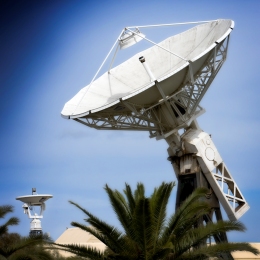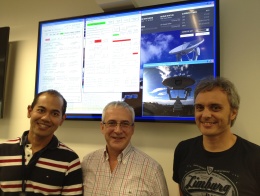05 June 2013
 University of South Australia engineers will play a vital role this week in the safe launch and successful flight of a European Space Agency (ESA) mission to the International Space Station.
University of South Australia engineers will play a vital role this week in the safe launch and successful flight of a European Space Agency (ESA) mission to the International Space Station.
Adelaide’s “rocket men”, Hidayat Soetiyono and Marc Lavenant, will track the progress of a European Space Agency-owned Ariane V rocket, due to launch 7.22 am this Thursday (Adelaide time). The launch will be from French Guiana, a French-owned region on the north Atlantic coast of South America.
“We’ll be recording data such as speed, location and status being sent from the Ariane rocket as it travels through the Earth’s atmosphere at 28,000km per hour,” Soetiyono says.
But the Ariane V is not the main star of this mission. It is merely a workhorse whose primary purpose is to carry an Automated Transfer Vehicle (ATV) – a kind of space cargo freighter - into orbit.
The ATV, christened Albert Einstein, will be packed with 2500kg of food, spare parts, propellant, water, gases, clothing and scientific experiments.
An hour after launch (a few minutes after the rocket passes Adelaide for the first time), the Albert Einstein will separate from the rocket, beginning a 10-day journey which ends when it docks at the International Space Station on June 15.
UniSA’s Institute for Telecommunications Research (ITR) is one of only six groups in the world tracking the mission.
Soetiyono and Lavenant will monitor the flight from a tracking centre at the Institute’s headquarters at UniSA’s Mawson Lakes campus.
One nail-biting moment the engineers must record is a vital rocket boost stage occurring over Adelaide, as the ITR is the only tracking station within range of this event.
 Are they nervous? As veterans of three previous ESA ATV launches, they say they are confident they can keep the rocket firmly in their sights.
Are they nervous? As veterans of three previous ESA ATV launches, they say they are confident they can keep the rocket firmly in their sights.
Preparations began seven months ago when two large receiver and storage computer systems arrived at ITR from the French National Centre for Space Studies (CNES).
The ITR team has spent many sleepless nights fine tuning the S-Band antenna (a 3 metre ground station satellite dish located on the roof of the ITR) that will pick up the signals being transmitted from the Ariane rocket.
They’ve rehearsed every moment of the launch and flight, in a complex multi-collaboration with the control centre in France, launch base in South America, and five other tracking stations.
Now Adelaide’s rocket men are preparing to clock on at midnight Wednesday to begin preparations for the launch seven hours later. They are good to go, as long as the coffee keeps coming.
For interviews, please contact:
Abbie Thomas, Institute for Telecommunications Research, 0414525492 abbie.thomas@unisa.edu.au
Jeff Kasparian, Institute for Telecommunications Research, 0408838660 jeff.kasparian@unisa.edu.au
For information on the mission
http://www.esa.int/Our_Activities/Operations/ATV-4_ready_to_deliver_essential_cargo_to_Space_Station
A video transmission of the launch will be available live on www.esa.int
For mission updates, and launch timeline http://www.blogs.esa.int/atv
News editors please note: The rocket men will be available on Thursday until 2 pm for filming in the control room or with the tracking dish at the ITR at Mawson Lakes campus.




